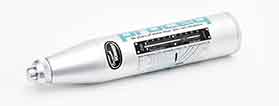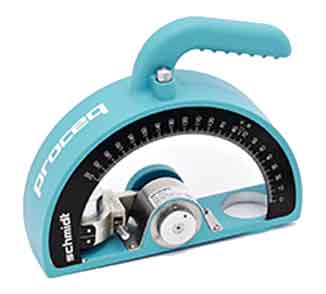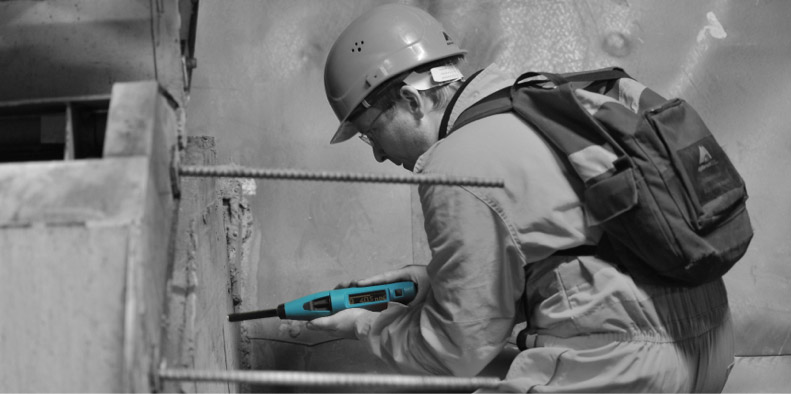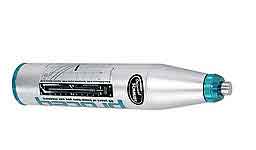Concrete Test Hammer
Original Schmidt
The quality of concrete is mainly judged by its compressive strength directly affecting the load-bearing capacity and durability of concrete structures. Proceq invented the Original Schmidt, the world’s first and now most widely used test hammer for analyzing the compressive strength of concrete properties.
The Original Schmidt will hit the concrete at a defined energy whereas its rebound is dependent on the hardness of the concrete and is measured by the instrument. The Original Schmidt is available in models with different impact energies, each test hammer designed for a specific test application, in order to meet the needs of the customers to investigate a wide range of material types and sizes, such as bridge decks, thin walls, cast stone components or small components.
Schmidt OS-120
The Schmidt OS-120 Pendulum Hammers are designed to test on softer material such as light weight concrete, gypsum boards, fresh concrete and the mortar of joints in brickwork. Their unique design allows easy to handle measurements on vertical and horizontal surfaces.
Schmidt OS-120 is the only rebound hammer worldwide working with the pendulum system, thus it must not be loaded on the test surface. The larger plunger surface on the Schmidt OS-120PT allows tests on soft concrete starting with a compressive strength of 1 MPa.
Digital SilverSchmidt
The SilverSchmidt ST/PC is the first integrated concrete test hammer featuring true rebound value and unmatched repeatability.
Two factors contribute to the improved performance of this concrete test hammer over its predecessors:
- Velocity based detection of the rebound quotient.
- The lightweight hybrid design of the impact plunger is made from aerospace alloy, matched to the elastic properties of the concrete and equipped with a hardness steel cap
Independent validation testing by BAM (Federal Institute for Materials Research and Testing, Germany) has shown the SilverSchmidt ST/PC to have less dispersion than the classical concrete test hammer over the entire range.
The unique design and high quality construction of the concrete test hammer SilverSchmidt ST/PC makes rebound hammer testing quicker and more accurate than ever before.
Analog Rebound Hammer
The Proceq rebound hammer is a device to measure the elastic properties or strength of concrete or rock. Each rebound hammer is built for a different purpose in order to meet the specific needs of the customer.
Proceq invented the world’s first and now most widely used equipment for analyzing concrete strength properties, the Original Schmidt. This rebound hammer is available in models with different impact energies, each designed for a specific test application.
The SilverSchmidt ST/PC is the latest generation of rebound hammer combining the ground breaking features of the OriginalSchmidt with the best of today’s technology. It’s the first integrated rebound hammer featuring true rebound value and unmatched repeatability.
Besides showing the basic settings on the included display unit, the rebound hammer DigiSchmidt offers the transmission of the measured data to a standard printer or to a PC. The window based software ProVista allows downloading, presenting and editing of the measured values in a fast and easy way. This rebound hammer is menu-guided in different languages.
The rebound hammer meets the customers' needs for in-situ measurement of concrete quality and compressive strength.
DigiSchmidt
The Schmidt Hammer Digi-Schmidt was developed for the non destructive measurement of the concrete compressive strength and controlling the uniform concrete quality.
Besides showing the basic settings on the included display unit, the Schmidt Hammer offers the transmission of the measured data to a standard printer or to a PC. This supersedes the time consuming business of note taking allowing the user to focus on the essential. The window based software ProVista allows downloading, presenting and editing of the measured values in a fast and easy way.
The Schmidt Hammer is equipped with a sensor which measures the rebound value of a test impact to high resolution and repeatability. With the Schmidt Hammer, various parameters such as impact direction, form factor and time factors such as carbonation depth can easily be set.
Ultrasonic Pulse Velocity (UPV)
Ultrasonic Pulse Velocity (UPV) testing of concrete is based on the pulse velocity method to provide information on the uniformity of concrete, cavities, cracks and defects. The pulse velocity in a material depends on its density and its elastic properties which in turn are related to the quality and the compressive strength of the concrete. It is therefore possible to obtain information about the properties of components by sonic investigations.
Proceq offers the most versatile instrument for ultrasonic Pulse Velocity (UPV) testing of concrete – the Pundit Lab, the newest member of the famous Pundit family. Along with the traditional transit time and pulse velocity measurement, this ultrasonic concrete testing equipment offers path length measurement, perpendicular crack depth measurement and surface velocity measurement.
Ultrasonic Pulse Velocity - Pundit Lab
The Pundit Lab is an ultrasonic pulse velocity (UPV) test instrument which is used to examine the quality of concrete. It features online data acquisition, waveform analysis and full remote control of all transmission parameters. Along with the traditional transit time and pulse velocity measurement, the ultrasonic test equipment Pundit Lab offers path length measurement, perpendicular crack depth measurement and surface velocity measurement. Optimized pulse shaping gives greater transmission range at lower voltage levels. This, coupled with automated combination of the transmitter voltage and the receiver gain, ensures an optimum received signal level, guaranteeing accurate and stable measurements. An integrated waveform display allows manual triggering of the received waveform.
Ultrasonic Pulse Velocity - Pundit Lab Plus
The Pundit Lab is an ultrasonic pulse velocity (UPV) test instrument which is used to examine the quality of concrete. The Pundit Lab+ comes with an extended feature set, making it particularly suitable for on-site measurements. Naturally it contains all of the features of the Pundit Lab. The new functions include, an integrated gain stage making an external amplifier unnecessary when using long cables or exponential transducers, a real time stamp for recording the time of measurement, a data review list that allows previous measurements to be viewed on site, and a correlation to compressive strength either directly from pulse velocity or in combination with a rebound value (SONREB method).
Ultrasonic Pulse Velocity - Pundit PL-200
The Pundit PL-200 is a best-in-class Ultrasonic pulse velocity (UPV) test instrument to examine the quality of concrete and other materials such as rock, wood and ceramics.
It provides an extended range of measurement modes and superior features for on-site testing: Assess the concrete uniformity using standard A-Scans, Line Scans and the new Area Scan functionality, estimate the compressive strength of concrete or measure the surface velocity and the depth of perpendicular cracks. The Data Logging measurement mode allows the automation of long term measurements.
The intelligent software supports directly accessible settings in real time from the measuring screen. The highest resolution and sharpest image available in the market allows best possible analysis of the measured waveforms.
Proceq offers an extensive range of transducers for the Pundit PL-200 providing highest accuracy and a proven field track record.
Ultrasonic Pulse Echo - Pundit PL-200PE
The Pundit PL-200PE employs state-of-the-art pulse echo technology to extend the ultrasonic application to objects where access is restricted to a single side.
The measurement process is greatly assisted by Proceq innovations such as advanced echo tracking and automatic estimation of Pulse Velocity. The A-Scan Mode allows direct analysis of the raw signal and the real-time B-Scan Mode provides a cross-sectional view perpendicular to the scanning surface. The Area Scan enables slab thickness uniformity testing in grid patterns.
This allows the user to determine the slab thickness and to localize subsurface deformities such as voids, pipes, delaminations and honeycombing.
Control buttons and optical feedback directly on the probe increase measurement efficiency and make to instrument even more user-friendly.
Rebar Detection
To allow certain constructions and to strengthen the concrete rebars are cast into it. Drilling through those reinforcing bars is a costly business that can be dangerous: Hitting a rebar while boring into the reinforced concrete can destroy the drilling instrument and can severely weaken the concrete structure. An instrument for rebar detection that quickly and accurately determines the location of the reinforcing bars in the concrete will significantly decrease construction time and costs.
The rebar detection instrument Profoscope has a unique real-time visualization mechanism, allowing the contractor to actually see the location of rebars beneath the concrete surface. The Profoscope+ features data storage for automatic collection of data to make rebar detection more efficient.
The Profometer PM-6 combines rebar detection and measurement of concrete cover and bar diameters in one instrument.
Rebar Detector and Covermeter - Profoscope – Entry Level Model
The Profoscope is a versatile, fully-integrated rebar detector and cover meter with a unique real-time rebar visualization allowing the user to actually “SEE” the location of the rebar beneath the concrete surface to a maximum depth of 180 mm. This is coupled with rebar-proximity indicators and optical and acoustical locating aids. Rebar diameter can also be estimated within the specified testing range. The Profoscope combines these unique features in a compact, light device that allows the user to operate this rebar detector with one hand making the task of locating rebars a simple and efficient process. In addition, Proceq’s rebar detector convinces through its intuitive user interface making rebar detection easy.
Additional memory function is available with the Profoscope+.
Rebar Locator - Profoscope+
The Profoscope+ is a fully integrated rebar locator with data storage. To increase the efficiency on the construction site this enhancement of the Profoscope not only offers real time visualization of rebars, but also automatic data collection.
Writing down measuring results of testing series is a time consuming business that can be an unnecessary source of errors. The various data storage modes of the rebar locator Profoscope+ make note taking obsolete. This cordless rebar detector is ideally suited for one-handed operations, keeping the other hand free for marking rebars.
The rebar locator Profoscope+ has the same features as the Profoscope, but additionally offers the innovative memory function for data acquisition.
Profometer PM-600 – Advanced Concrete Cover Meter
Profometer PM-600 is an advanced cover meter for the precise and non destructive measurement of concrete cover and rebar diameters and the detection of rebar locations using the eddy current principle with pulse induction as the measuring method.
Based on the new generation Profometer Touchscreen unit, the instrument offers real time control over the measurement procedure directly on site. The high resolution color display allows best possible measuring and analysis of the statistical data for an entire working day (battery lifetime > 8h).
The instrument comes along with a Universal Probe including a spot probe especially suited for areas with congested rebar arrangement such as columns, girders and slabs over columns.
Profometer PM-630 – Advanced Concrete Scan Cover Meter
The Profometer PM-630 advanced cover meter is a sophisticated instrument extending the application range of the Profometer PM-600 with the Line and Area Scan Modes and an extensive choice of statistical views.
It is specially suited to measuring large areas, long lines or when comprehensive reporting is required. For example when inspecting tunnels, retaining walls, concrete slab soffits, bridge slabs or dams.
Based on the new generation Profometer Touchscreen unit, the instrument offers real time control over the measurement procedure directly on site. The high resolution color display allows best possible measuring and analysis of the statistical data for an entire working day (battery lifetime > 8h).
Profometer PM-650
The Profometer PM-650 extends the measuring modes of the Profometer PM-630 with the unique Cross-Line Mode and further analysis functions. The Cross-Line Mode allows users to measure the rebars of the first and second layer typically arranged in a rectangular mesh.
Corrosion Monitoring
Since reinforced concrete will be subject to a corrosion process that ultimately leads to a total failure of the structure, corrosion monitoring is essential. In the first stage, aggressive elements penetrate into the structure. On reaching the rebars, high concentrations of those elements attack the passive layer of hydrated iron oxide that protects the rebar against corrosion. Rust begins to form which eventually leads to structural failure. Early diagnosis and monitoring of seemingly healthy concrete cover allows pre-emptive corrosion control measures to reduce unwanted risks.
The Canin+ is an instrument for corrosion monitoring allowing rapid, comprehensive tests of the site and provides a assessment of locations where corrosion is likely to take place before the rust becomes visible. This corrosion monitoring allows the user to reduce the costs of corrective maintenance significantly.
Canin+
Corrosion Analysis allows the contractor to limit the maintenance tasks on reinforced concrete to the areas where it is really required. The Canin+ is the fastest instrument for corrosion analysis, offering a practical, cost-effective approach to the investigation of reinforced concrete. Corrosion analysis with the Canin+ allows a rapid, comprehensive test of the site and provides a fast assessment of locations where corrosion is likely to take place. Corrosion analysis with the half-cell potential method: accurate field potential measurements aid in detecting active corrosion in rebars.
Resipod Resistivity Meter
Resipod is a fully integrated 4-point Wenner probe, designed to measure the electrical resistivity of concrete in a completely non-destructive test. It is the most accurate instrument available, extremely fast and stable and packaged in a robust, waterproof housing designed to operate in a demanding site environment. The Resipod is the successor of the classic CNS Farnell Resistivity Meter.
Surface resistivity measurement provides extremely useful information about the state of a concrete structure. Not only has it been proven to be directly linked to the likelihood of corrosion and the corrosion rate, recent studies have shown that there is a direct correlation between resistivity and chloride diffusion rate and even to determination of early compressive strength. This makes it one of the most versatile NDT methods for concrete.
Hygropin Moisture Meter
Excess moisture in concrete can be fatal to a floor covering installation. To prevent mildew and major damage, the flooring industry requires smart solutions to check surfaces for moisture prior to installing floor coverings or coatings. The Hygropin moisture meter offers the perfect solution to identify and monitor moisture in concrete. Due to the small and fast sensor of the moisture meter, diagnosing moisture according to ASTM F2170-09 is quicker and easier than ever before. The relative humidity test requires placing a measuring sleeve at a specific depth. This can be done either by drilling a hole or by pre-installing cast holes in fresh concrete. This moisture meter provides the smallest available sensor on the market, minimizing damage to the surface and reducing the installation efforts immensely.
Resipod Resistivity Meter
Resipod is a fully integrated 4-point Wenner probe, designed to measure the electrical resistivity of concrete in a completely non-destructive test. It is the most accurate instrument available, extremely fast and stable and packaged in a robust, waterproof housing designed to operate in a demanding site environment. The Resipod is the successor of the classic CNS Farnell Resistivity Meter.
Surface resistivity measurement provides extremely useful information about the state of a concrete structure. Not only has it been proven to be directly linked to the likelihood of corrosion and the corrosion rate, recent studies have shown that there is a direct correlation between resistivity and chloride diffusion rate and even to determination of early compressive strength. This makes it one of the most versatile NDT methods for concrete.
Permeability Test
The permeability of concrete at the surface is a major factor in determining the durability of concrete structures. A reliable permeability test of the concrete cover is therefore crucial – not only in the laboratory but also at the building site. One factor determining the durability of concrete is the ease with which air can penetrate into concrete.
The permeability test with the Torrent permits a rapid analysis of the air permeability of the cover concrete by a non destructive method. The essential features of the permeability test method of the Torrent are a two-chamber vacuum cell and a pressure regulator which ensures an air flow at right angles to the surface into the inner chamber. The permeability test with the Torrent takes only 2 – 12 minutes
Permeability Tester - Torrent
The Torrent permeability tester permits a rapid and non destructive measurement of the quality of the cover concrete with respect to its durability. Concrete permeability is an excellent indicator of the potential durability and resistance of a particular concrete against the ingress of aggressive media in the gaseous or liquid state. A measurement with Proceq’s permeability tester takes 2-12 minutes.
Pull Off Tester - DY-2 Family
The Proceq DY-2 Family of automated pull-off testers covers the complete range of pull-off applications with unmatched ease of operation and a unique capability to store a complete record of the test.
Pull-off testing is one of the most widely used test methods in the construction industry. This is reflected in the huge number of standards dedicated to the method.
It has long been known that one of the major influences on the result of a pull-off test is the operator influence in the application of a constant load rate. The DY-2 with its integrated, feedback controlled motor removes this variable completely, by providing a fully automated test at a constant load rate which can be verified.
Hydrawjaws Pull Out Testers
Hydrajaws M2008 HEAVY DUTY
The Profometer 5+ cover meter is a sophisticated device for the non destructive location of rebars and for the measurement of concrete cover and bar diameters, using the eddy current principle with pulse induction as the measuring method. As well as detecting the rebar diameter accurately to the millimeter by only one measuring procedure, the cover meter Profometer 5+ offers the transmission of the measured data to a PC. This supersedes the time consuming business of note taking, allowing the user to focus on the essential.
Proceq offers two different models of the Profometer 5+ cover meter, each designed to meet the individual needs of the customer:
-
Profometer 5+ cover meter Model S (Basic Unit) performs the following functions:
- Locating rebar
- Concrete cover meter
- Storing individual cover values and statistical evaluation
- Determining the bar diameters
-
The Profometer 5+ cover meter Model Scanlog has all the function of the model S but offers additionally the following features:
- 2-dimensional display of rebar layout
- 2-dimensional display and mapping of concrete cover values
The cover meter meets the customers' needs for digital rebar location.
Hydrajaws M2000 MATERIAL BOND
A pull off tester is indispensable for the diagnosis of building structure damages as well as for checking complete renovation work. The Dyna pull off tester is used to determine the surface strength of concrete and other materials testing it directly on the component allowing the use of any measuring point. Additionally, the Dyna pull off tester can be used for the measuring of the adhesive strength of applied coatings such as plastic coatings, concrete coats, and mortars and plasters. This mobile pull off tester allows testing on any point of a structure without having to install test devices prior to the casting of concrete.





